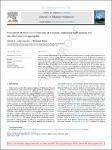Evaluation of modulus of elasticity of concrete containing both natural and recycled concrete aggregates
| dc.contributor.author | Li, Z | |
| dc.contributor.author | Li, L-Y | |
| dc.contributor.author | Cheng, S | |
| dc.date.accessioned | 2024-03-01T15:39:38Z | |
| dc.date.available | 2024-03-01T15:39:38Z | |
| dc.date.issued | 2024-02 | |
| dc.identifier.issn | 0959-6526 | |
| dc.identifier.other | 141591 | |
| dc.identifier.uri | https://pearl.plymouth.ac.uk/handle/10026.1/22116 | |
| dc.description.abstract |
There is growing requirement to use recycled aggregate in concrete to demote industrial wastes produced by construction sectors. Thus, to develop simple but meaningful formulations to assess the mechanical properties of concrete, when it is mixed with both natural and recycled aggregates, becomes essential. In the present study an analytical approach to calculate the elastic modulus of concrete containing both natural and recycled concrete aggregates is proposed. The approach is developed on the concept of effective medium approximation but considering the effect of Poisson's ratio. Two analytical formulas are derived. One is for the two-phase concrete (mortar and aggregate) that is mixed with 100% natural aggregate or 100% recycled concrete aggregate. The other is for the three-phase concrete (mortar, natural aggregate, and recycled concrete aggregate) that is mixed with both natural and recycled aggregates. The analytical formulations are validated using the results obtained from both the numerical simulations and experimental tests. The present analytical model not only provides the simple and meaningful formulations to calculate the effective elastic modulus but also can be used to directly examine the influence of mortar, natural aggregate, recycled concrete aggregate and its replacement ratio to natural aggregate on the elastic modulus of the mixed concrete. | |
| dc.language | en | |
| dc.publisher | Elsevier BV | |
| dc.title | Evaluation of modulus of elasticity of concrete containing both natural and recycled concrete aggregates | |
| dc.type | Journal Article | |
| plymouth.publisher-url | http://dx.doi.org/10.1016/j.jclepro.2024.141591 | |
| plymouth.publication-status | Published | |
| plymouth.journal | Journal of Cleaner Production | |
| dc.identifier.doi | 10.1016/j.jclepro.2024.141591 | |
| plymouth.organisational-group | |Plymouth | |
| plymouth.organisational-group | |Plymouth|Research Groups | |
| plymouth.organisational-group | |Plymouth|Faculty of Science and Engineering | |
| plymouth.organisational-group | |Plymouth|Faculty of Science and Engineering|School of Engineering, Computing and Mathematics | |
| plymouth.organisational-group | |Plymouth|Research Groups|Marine Institute | |
| plymouth.organisational-group | |Plymouth|REF 2021 Researchers by UoA | |
| plymouth.organisational-group | |Plymouth|Users by role | |
| plymouth.organisational-group | |Plymouth|Users by role|Academics | |
| plymouth.organisational-group | |Plymouth|REF 2021 Researchers by UoA|UoA12 Engineering | |
| plymouth.organisational-group | |Plymouth|REF 2029 Researchers by UoA | |
| plymouth.organisational-group | |Plymouth|REF 2029 Researchers by UoA|UoA12 Engineering | |
| dc.date.updated | 2024-03-01T15:39:31Z | |
| dc.rights.embargodate | 2024-03-09 | |
| rioxxterms.versionofrecord | 10.1016/j.jclepro.2024.141591 |


